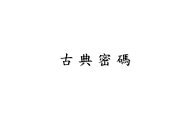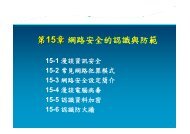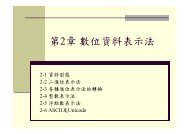Synchronous Sequential Logic
Synchronous Sequential Logic
Synchronous Sequential Logic
You also want an ePaper? Increase the reach of your titles
YUMPU automatically turns print PDFs into web optimized ePapers that Google loves.
<strong>Synchronous</strong> <strong>Sequential</strong> <strong>Logic</strong><br />
Chapter 5
5-1 Introduction<br />
• Combinational circuits<br />
• contains no memory elements<br />
• the outputs depends on the inputs<br />
<strong>Synchronous</strong> <strong>Sequential</strong> <strong>Logic</strong> 5-2
5-2 <strong>Sequential</strong> Circuits<br />
• <strong>Sequential</strong> circuits<br />
• a feedback path<br />
• the state of the sequential circuit<br />
• (inputs, current state) (outputs, next state)<br />
• synchronous: the transition happens at discrete<br />
instants of time<br />
• asynchronous: at any instant of time<br />
<strong>Synchronous</strong> <strong>Sequential</strong> <strong>Logic</strong> 5-3
• <strong>Synchronous</strong> sequential circuits<br />
• a master-clock generator to generate a periodic<br />
train of clock pulses<br />
• the clock pulses are distributed throughout the<br />
system<br />
• clocked sequential circuits<br />
• most commonly used<br />
• no instability problems<br />
• the memory elements: flip-flops<br />
• binary cells capable of storing one bit of information<br />
• two outputs: one for the normal value and one for the<br />
complement value<br />
• maintain a binary state indefinitely until directed by an<br />
input signal to switch states<br />
<strong>Synchronous</strong> <strong>Sequential</strong> <strong>Logic</strong> 5-4
<strong>Synchronous</strong> <strong>Sequential</strong> <strong>Logic</strong> 5-5
5-3 Latches<br />
• Basic flip-flop circuit<br />
• two NOR gates<br />
• more complicated types can be built upon it<br />
• directed-coupled RS flip-flop: the cross-coupled connection<br />
• an asynchronous sequential circuit<br />
• (S,R)= (0,0): no operation<br />
(S,R)=(0,1): reset (Q=0, the clear state)<br />
(S,R)=(1,0): set (Q=1, the set state)<br />
(S,R)=(1,1): indeterminate state (Q=Q'=0)<br />
• consider (S,R) = (1,1) (0,0) <strong>Synchronous</strong> <strong>Sequential</strong> <strong>Logic</strong> 5-6
• SR latch with NAND gates<br />
<strong>Synchronous</strong> <strong>Sequential</strong> <strong>Logic</strong> 5-7
• SR latch with control input<br />
• C=0, no change<br />
• C=1,<br />
<strong>Synchronous</strong> <strong>Sequential</strong> <strong>Logic</strong> 5-8
• D Latch (Transparent Latch)<br />
• eliminate the undesirable conditions of the<br />
indeterminate state in the RS flip-flop<br />
• D: data<br />
• gated D-latch<br />
• D Q when C=1; no change when C=0<br />
<strong>Synchronous</strong> <strong>Sequential</strong> <strong>Logic</strong> 5-9
Graphic symbols<br />
<strong>Synchronous</strong> <strong>Sequential</strong> <strong>Logic</strong><br />
5-10
5-4 Flip-Flops<br />
• A trigger<br />
• The state of a latch or flip-flop is switched by a<br />
change of the control input<br />
• Level triggered –latches<br />
• Edge triggered –flip-flops<br />
<strong>Synchronous</strong> <strong>Sequential</strong> <strong>Logic</strong> 5-11
• If level-triggered flip-flops are used<br />
• the feedback path may cause instability problem<br />
• Edge-triggered flip-flops<br />
• the state transition happens only at the edge<br />
• eliminate the multiple-transition problem<br />
<strong>Synchronous</strong> <strong>Sequential</strong> <strong>Logic</strong> 5-12
Edge-triggered D flip-flop<br />
• Master-slave D flip-flop<br />
• two separate flip-flops<br />
• a master flip-flop (positive-level triggered)<br />
• a slave flip-flop (negative-level triggered)<br />
<strong>Synchronous</strong> <strong>Sequential</strong> <strong>Logic</strong> 5-13
• Edge-triggered flip-flops<br />
• the state changes during a clock-pulse transition<br />
• A D-type positive-edge-triggered flip-flop<br />
<strong>Synchronous</strong> <strong>Sequential</strong> <strong>Logic</strong> 5-14
• three basic flip-flops<br />
• (S,R) = (0,1): Q = 1<br />
• (S,R) = (1,0): Q = 0<br />
• (S,R) = (1,1): no operation<br />
• (S,R) = (0,0): should be avoided<br />
<strong>Synchronous</strong> <strong>Sequential</strong> <strong>Logic</strong> 5-15
• The setup time<br />
• D input must be maintained at a constant value prior to the<br />
application of the positive CP pulse<br />
• = the propagation delay through gates 4 and 1<br />
• data to the internal latches<br />
• The hold time<br />
• D input must not changes after the application of the positive<br />
CP pulse<br />
• = the propagation delay of gate 3<br />
• clock to the internal latch<br />
<strong>Synchronous</strong> <strong>Sequential</strong> <strong>Logic</strong> 5-16
• Summary<br />
• CP=0: (S,R) = (1,1), no state change<br />
• CP=: state change once<br />
• CP=1: state holds<br />
• eliminate the feedback problems in sequential<br />
circuits<br />
• All flip-flops must make their transition at the<br />
same time<br />
<strong>Synchronous</strong> <strong>Sequential</strong> <strong>Logic</strong> 5-17
Graphic symbols<br />
• The edge-triggered D flip-flops<br />
• The most economical and efficient<br />
• Positive-edge and negative-edge<br />
<strong>Synchronous</strong> <strong>Sequential</strong> <strong>Logic</strong> 5-18
Other Flip-Flops<br />
• JK flip-flop<br />
• D=JQ'+K'Q<br />
• J=0, K=0: D=Q, no change<br />
• J=0, K=1: D=0 Q =0<br />
• J=1, K=0: D=1 Q =1<br />
• J=1, K=1: D=Q' Q =Q'<br />
<strong>Synchronous</strong> <strong>Sequential</strong> <strong>Logic</strong><br />
5-19
• T flip-flop<br />
• D = T⊕Q = TQ'+T'Q<br />
• T=0: D=Q, no change<br />
• T=1: D=Q' Q=Q'<br />
<strong>Synchronous</strong> <strong>Sequential</strong> <strong>Logic</strong> 5-20
• Characteristic Tables<br />
<strong>Synchronous</strong> <strong>Sequential</strong> <strong>Logic</strong><br />
5-21
• Characteristic Equations<br />
• D flip-flop<br />
• Q(t+1) = D<br />
• JK flip-flop<br />
• Q(t+1) = JQ'+K'Q<br />
• T flop-flop<br />
• Q(t+1) = T⊕Q<br />
<strong>Synchronous</strong> <strong>Sequential</strong> <strong>Logic</strong><br />
5-22
Direct inputs<br />
• asynchronous set and/or asynchronous reset<br />
<strong>Synchronous</strong> <strong>Sequential</strong> <strong>Logic</strong> 5-23
<strong>Synchronous</strong> <strong>Sequential</strong> <strong>Logic</strong> 5-24
5-5 Analysis of Clocked <strong>Sequential</strong> Ckts<br />
• A sequential circuit<br />
• (inputs, current state) (output, next state)<br />
• a state transition table or state transition diagram<br />
<strong>Synchronous</strong> <strong>Sequential</strong> <strong>Logic</strong> 5-25
State equations<br />
• A(t+1) = A(t)x(t) + B(t)x(t)<br />
• B(t+1) = A'(t)x(t)<br />
• A more compact form<br />
• A(t+1) = Ax + Bx<br />
• B(t+1) = Ax<br />
• The output equation<br />
• y(t) = (A(t)+B(t))x'(t)<br />
• y = (A+B)x'<br />
<strong>Synchronous</strong> <strong>Sequential</strong> <strong>Logic</strong> 5-26
State table<br />
• State transition table<br />
• = state equations<br />
<strong>Synchronous</strong> <strong>Sequential</strong> <strong>Logic</strong> 5-27
State equation<br />
A(t + 1) =Ax + Bx<br />
B(t + 1) = Ax<br />
y = Ax+ Bx<br />
<strong>Synchronous</strong> <strong>Sequential</strong> <strong>Logic</strong> 5-28
State diagram<br />
• State transition diagram<br />
• a circle: a state<br />
• a directed lines connecting the circles: the<br />
transition between the states<br />
• Each directed line is labeled 'inputs/outputs‘<br />
• a logic diagram a state table a state diagram<br />
<strong>Synchronous</strong> <strong>Sequential</strong> <strong>Logic</strong> 5-29
Flip-flop input equations<br />
• The part of circuit that generates the inputs to<br />
flip-flops<br />
• Also called excitation functions<br />
• D Q = x + y<br />
• D A = Ax +Bx<br />
• D B = A'x<br />
• The output equations<br />
• to fully describe the sequential circuit<br />
• y = (A+B)x'<br />
<strong>Synchronous</strong> <strong>Sequential</strong> <strong>Logic</strong> 5-30
Analysis with D flip-flops<br />
• The input equation<br />
• D A =A⊕x⊕y<br />
• The state equation<br />
• A(t+1)=A⊕x⊕y<br />
<strong>Synchronous</strong> <strong>Sequential</strong> <strong>Logic</strong> 5-31
Analysis with JK flip-flops<br />
• Determine the flip-flop input function in terms of<br />
the present state and input variables<br />
• Used the corresponding flip-flop characteristic<br />
table to determine the next state<br />
<strong>Synchronous</strong> <strong>Sequential</strong> <strong>Logic</strong> 5-32
• J A = B, K A = Bx'<br />
• J B = x', K B = A'x + Ax‘<br />
• derive the state table<br />
• Or, derive the state equations using characteristic eq.<br />
<strong>Synchronous</strong> <strong>Sequential</strong> <strong>Logic</strong> 5-33
• State transition diagram<br />
A( t 1)<br />
JA <br />
KA<br />
B( t 1)<br />
JB <br />
KB<br />
State equation for A and B:<br />
A( t 1) BA ( Bx ) A A B AB <br />
Ax<br />
B( t 1) x B ( Ax)<br />
B B x ABx A<br />
Bx<br />
<br />
<strong>Synchronous</strong> <strong>Sequential</strong> <strong>Logic</strong> 5-34
Analysis with T flip-flops<br />
• The characteristic equation<br />
• Q(t+1)= T⊕Q = TQ'+T'Q<br />
<strong>Synchronous</strong> <strong>Sequential</strong> <strong>Logic</strong> 5-35
• The input and output functions<br />
• T A =Bx<br />
• T B = x<br />
• y = AB<br />
• The state equations<br />
• A(t+1) = (Bx)'A+(Bx)A' =AB'+Ax'+A'Bx<br />
• B(t+1) = x⊕B<br />
<strong>Synchronous</strong> <strong>Sequential</strong> <strong>Logic</strong> 5-36
State Table<br />
<strong>Synchronous</strong> <strong>Sequential</strong> <strong>Logic</strong> 5-37
Mealy and Moore models<br />
• the Mealy model: the outputs are functions of<br />
both the present state and inputs (Fig. 5-15)<br />
• the outputs may change if the inputs change<br />
during the clock pulse period<br />
• the outputs may have momentary false values unless the<br />
inputs are synchronized with the clocks<br />
• The Moore model: the outputs are functions<br />
of the present state only (Fig. 5-20)<br />
• The outputs are synchronous with the clocks<br />
<strong>Synchronous</strong> <strong>Sequential</strong> <strong>Logic</strong> 5-38
<strong>Synchronous</strong> <strong>Sequential</strong> <strong>Logic</strong> 5-39
5-7 State Reduction and Assignment<br />
• State Reduction<br />
• reductions on the number<br />
of flip-flops and the<br />
number of gates<br />
• a reduction in the number<br />
of states may result in a<br />
reduction in the number<br />
of flip-flops<br />
• a example state diagram<br />
<strong>Synchronous</strong> <strong>Sequential</strong> <strong>Logic</strong> 5-40
• only the input-output sequences<br />
are important<br />
• two circuits are equivalent<br />
• have identical outputs for all input<br />
sequences<br />
• the number of states is not important<br />
<strong>Synchronous</strong> <strong>Sequential</strong> <strong>Logic</strong> 5-41
• Equivalent states<br />
• two states are said to be equivalent<br />
• for each member of the set of inputs, they give exactly<br />
the same output and send the circuit to the same state or<br />
to an equivalent state<br />
• one of them can be removed<br />
<strong>Synchronous</strong> <strong>Sequential</strong> <strong>Logic</strong> 5-42
• Reducing the state table<br />
• e=f<br />
• d=?<br />
<strong>Synchronous</strong> <strong>Sequential</strong> <strong>Logic</strong> 5-43
• the reduced finite state machine<br />
<strong>Synchronous</strong> <strong>Sequential</strong> <strong>Logic</strong> 5-44
• the checking of each pair of states for possible<br />
equivalence can be done systematically<br />
• the unused states are treated as don't-care<br />
condition fewer combinational gates<br />
<strong>Synchronous</strong> <strong>Sequential</strong> <strong>Logic</strong> 5-45
State assignment<br />
• to minimize the cost of the combinational circuits<br />
• three possible binary state assignments<br />
<strong>Synchronous</strong> <strong>Sequential</strong> <strong>Logic</strong> 5-46
• any binary number assignment is satisfactory as<br />
long as each state is assigned a unique number<br />
• use binary assignment 1<br />
<strong>Synchronous</strong> <strong>Sequential</strong> <strong>Logic</strong> 5-47
5-8 Design Procedure<br />
• the word description of the circuit behavior (a state<br />
diagram)<br />
• state reduction if necessary<br />
• assign binary values to the states<br />
• obtain the binary-coded state table<br />
• choose the type of flip-flops<br />
• derive the simplified flip-flop input equations and<br />
output equations<br />
• draw the logic diagram<br />
<strong>Synchronous</strong> <strong>Sequential</strong> <strong>Logic</strong> 5-48
Synthesis using D flip-flops<br />
• An example state diagram and state table<br />
<strong>Synchronous</strong> <strong>Sequential</strong> <strong>Logic</strong> 5-49
• The flip-flop input equations<br />
• A(t+1) = D A (A,B,x) = (3,5,7)<br />
• B(t+1) = D B (A,B,x) = (1,5,7)<br />
• The output equation<br />
• y(A,B,x) = (6,7)<br />
• <strong>Logic</strong> minimization using the K map<br />
• D A = Ax + Bx<br />
• D B = Ax + B'x<br />
• y = AB<br />
<strong>Synchronous</strong> <strong>Sequential</strong> <strong>Logic</strong> 5-50
<strong>Synchronous</strong> <strong>Sequential</strong> <strong>Logic</strong> 5-51
Sequence detector<br />
• The logic diagram<br />
<strong>Synchronous</strong> <strong>Sequential</strong> <strong>Logic</strong> 5-52
Excitation tables<br />
• A state diagram flip-flop input functions<br />
• straightforward for D flip-flops<br />
• we need excitation tables for JK and T flip-flops<br />
<strong>Synchronous</strong> <strong>Sequential</strong> <strong>Logic</strong> 5-53
Synthesis using JK flip-flops<br />
• The same example<br />
• The state table and JK flip-flop inputs<br />
<strong>Synchronous</strong> <strong>Sequential</strong> <strong>Logic</strong> 5-54
• J A = Bx'; K A = Bx<br />
• J B = x; K B = (A⊕x)‘<br />
• y = ?<br />
<strong>Synchronous</strong> <strong>Sequential</strong> <strong>Logic</strong> 5-55
<strong>Synchronous</strong> <strong>Sequential</strong> <strong>Logic</strong> 5-56
Synthesis using T flip-flops<br />
• A n-bit binary counter<br />
• the state diagram<br />
• no inputs (except for the clock input)<br />
<strong>Synchronous</strong> <strong>Sequential</strong> <strong>Logic</strong><br />
5-57
• The state table and the flip-flop inputs<br />
<strong>Synchronous</strong> <strong>Sequential</strong> <strong>Logic</strong> 5-58
<strong>Synchronous</strong> <strong>Sequential</strong> <strong>Logic</strong> 5-59
• <strong>Logic</strong> simplification using the K map<br />
• T A2 = A 1 A 2<br />
• T A1 = A 0<br />
• T A0 = 1<br />
• The logic diagram<br />
<strong>Synchronous</strong> <strong>Sequential</strong> <strong>Logic</strong> 5-60










